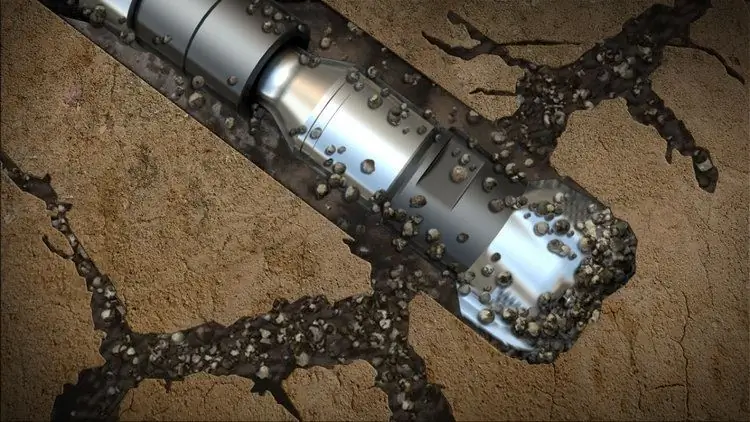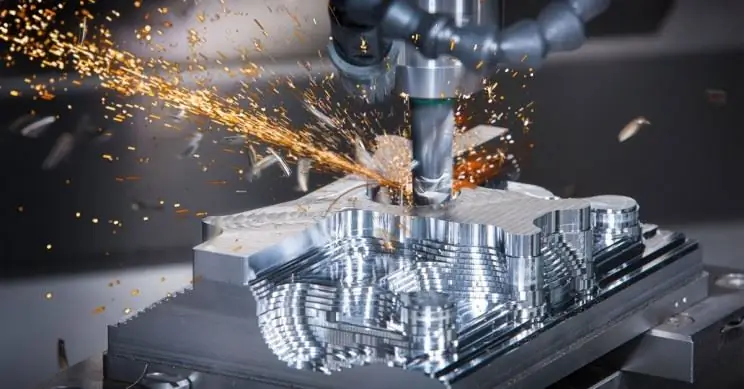2026 Author: Howard Calhoun | [email protected]. Last modified: 2025-06-01 07:12:56
Titanium carbide is one of the promising analogues of tungsten. It is not inferior to the latter in terms of physical and mechanical properties, and the manufacture of this compound is more economical. It is most widely used in the production of carbide cutting tools, as well as in the oil and general engineering, aviation and rocket industries.
Description and history of discovery
Titanium carbide occupies a special place among the transition metal compounds of the Periodic Table of Chemical Elements. It is distinguished by its special hardness, heat resistance and strength, which determines its widespread use as the basis for hard alloys that do not contain tungsten. The chemical formula of this substance is TiC. Outwardly, it is a light gray powder.

Its production began in the 1920s, when companies producing incandescent bulbs were looking for an alternative to the expensive technology for manufacturing tungsten filaments. As a result, a method for producing cemented carbide was invented. This technology was less expensive, since raw materials -titanium dioxide was more affordable.
In 1970, the use of titanium nitrite began, which made it possible to increase the viscosity of cemented joints, and chromium and nickel additives made it possible to increase the corrosion resistance of titanium carbide. In 1980, a process was developed for powder sintering under the influence of uniform compression (pressing). This improved the quality of the material. Sintered carbide powders are currently used in applications where high temperature, wear and oxidation resistance is required.
Chemical characteristics
The chemical properties of titanium carbide determine its practical importance in technology. This compound has the following characteristics:
- resistance to HCl, HSO4, H3PO4, alkali;
- high corrosion resistance in alkaline and acid solutions;
- no interaction with zinc melts, the main types of metallurgical slag;
- active oxidation only at temperatures above 1100 °C;
- melt wettability of steel, cast iron, nickel, cob alt, silicon;
- formation of TiCl4 in chlorine medium at t>40 °C.

Physical and mechanical properties
The main physical and mechanical characteristics of this substance are:
- Thermophysical: melting point - 3260±150 °C; boiling point - 4300 ° C; heat capacity - 50, 57 J/(K∙mol); thermal conductivity at 20 °C (depending on the contentcarbon) - 6.5-7.1 W/(m∙K).
- Strength (at 20 °C): compressive strength - 1380 MPa; tensile strength (hot-pressed carbide) - 500 MPa; microhardness - 15,000-31,500 MPa; impact strength - 9.5∙104 kJ/m2; hardness on the Mohs scale - 8-9 units.
- Technological: wear rate (depending on carbon content) - 0.2-2 µm/h; friction coefficient - 0.4-0.5; weldability is poor.
Receive
Titanium carbide production is carried out by several methods:
- Carbon-thermal method from titanium dioxide and solid carburizing materials (68 and 32% in the mixture, respectively). As the latter, soot is most often used. The raw material is first pressed into briquettes, which are then placed in a crucible. Carbon saturation takes place at a temperature of 2000 °C in a protective atmosphere of hydrogen.
- Direct carbidization of titanium powder at 1600 °C.
- Pseudo-melting - heating of metal powder with soot briquettes in a two-stage scheme up to 2050 °C. Soot dissolves in the titanium melt, and the output is carbide grains up to 1 thousand microns in size.
- Ignition in a vacuum of a mixture of titanium powder and carbon black (previously briquetted). The combustion reaction lasts a few seconds, then the composition is cooled.
- Plasma-chemical method from halides. This method makes it possible to obtain not only carbide powder, but also coatings, fibers, single crystals. The most common mixture is titanium chloride, methane and hydrogen. The process is carried out at a temperature1200-1500°C. The plasma flow is created using an arc discharge or in high-frequency generators.
- From titanium alloy chips (hydrogenation, grinding, dehydrogenation, carbonation or carbon black carbidization).

The product made by one of these methods is processed in grinding units. Grinding into powder is carried out to particle sizes of 1-5 microns.
Fibers and crystals
Obtaining titanium carbide in the form of single crystals is carried out in several ways:
- Method of melting. There are several varieties of this technology: the Verneuil process; drawing from a liquid bath formed by melting the sintered rods; electrothermal method in arc furnaces. These techniques are not widely used because they require high energy costs.
- Solution method. A mixture of titanium and carbon compounds, as well as metals that play the role of a solvent (iron, nickel, cob alt, aluminum or magnesium), are heated in a graphite crucible to 2000 ° C in a vacuum. The metal melt is kept for several hours, then treated with hydrochloric acid solutions and hydrogen fluoride, washed and dried, floated in a mixture of trichlorethylene and acetone to remove graphite. This technology produces crystals of high purity.
- Plasma-chemical synthesis in a reactor during the interaction of a plasma jet with titanium halides TiCl4, TiI4. Methane, ethylene, benzene, toluene and others are used as a carbon source.hydrocarbons. The main disadvantages of this method are the technological complexity and toxicity of raw materials.

Fibers are obtained by deposition of titanium chloride in a gaseous medium (propane, carbon tetrachloride mixed with hydrogen) at a temperature of 1250-1350 °C.
Application of titanium carbide
This compound is used as a component in the manufacture of heat-resistant, heat-resistant and hard tungsten-free alloys, wear-resistant coatings, abrasive materials.
Titanium carbide carbide systems are used for the following products:
- tools for metal cutting;
- parts of rolling machines;
- heat-resistant crucibles, thermocouple parts;
- furnace lining;
- jet engine parts;
- non-consumable welding electrodes;
- elements of equipment designed for pumping aggressive materials;
- abrasive pastes for polishing and finishing surfaces.

Parts are made by powder metallurgy:
- by sintering and hot pressing;
- by slip casting in plaster molds and sintering in graphite furnaces;
- by pressing and sintering.
Coatings
Titanium carbide coatings allow you to increase the performance of parts and at the same time save on expensive materials. They are characterized by the following properties:
- high wear resistance and hardness;
- chemical stability;
- low coefficient of friction;
- low propensity for cold welding;
- scale resistance.

A layer of titanium carbide is applied to the base material in several ways:
- Vapor deposition.
- Plasma or detonation spraying.
- Laser cladding.
- Ion-plasma spraying.
- Electro-spark alloying.
- Diffusion saturation.
Cermet is also made on the basis of titanium carbide and nickel heat-resistant alloys - a composite material that allows to increase the wear resistance of parts in liquid media by 10 times. The use of this composite is promising for increasing the service life of pumping equipment and other equipment, which include injection nozzles for maintaining reservoir pressure, flare burners, drill bits, valves.
Carbidesteel
Tungsten and titanium carbides are used for the manufacture of carbide steels, which in their properties occupy an intermediate position between hard alloys and high-speed steels. Refractory metals provide them with high hardness, strength and wear resistance, and the steel matrix - toughness and ductility. The mass fraction of titanium and tungsten carbide can be 20-70%. Such materials are obtained by the methods of powder metallurgy indicated above.

Carbide steels are used for the production of cutting tools, as well as machine parts,working in conditions of strong mechanical and corrosive wear (bearings, gears, bushings, shafts and others).
Recommended:
Polyols are polyhydric alcohols (polyalcohols): properties, production and applications

Polyols - safe or not? What are polyalcohols, why are they included in the composition of chocolate, chewing gum, foam rubber and antifreeze. The most famous polyols are sweeteners. Production of polyhydric alcohols in Russia and abroad
Montmorillonite clay: mineral composition, properties, extraction and applications

Montmorillonite clay is actually a mineral that is very plastic, hence its name. The breed was first mined in France. Currently, a large number of deposits have been developed around the world. Montmorillonite has excellent adsorbing properties. It easily absorbs water and various components, increasing in size up to 20 times. Currently, the mineral is used in many industries
Cement slurry: properties, preparation rules, composition, compliance with GOST requirements, purpose and application

During the drilling process, special solutions are used to flush out cuttings and products from the development of local rock. This operation is necessary to increase the efficiency of the mechanical impact of the drilling rig and to clear the bottom hole. Washing out is carried out using cement slurries, which are prepared using special technologies
Steel: composition, properties, types and applications. Composition of stainless steel

Today, steel is used in the vast majority of industries. However, not everyone knows that the composition of steel, its properties, types and applications are very different from the production process of this product
Titanium processing: initial properties of the material, difficulties and types of processing, principle of operation, techniques and recommendations of specialists

Today, people are processing a wide variety of materials. Titanium processing stands out among the most problematic types of work. The metal has excellent qualities, but because of them, most of the problems arise

